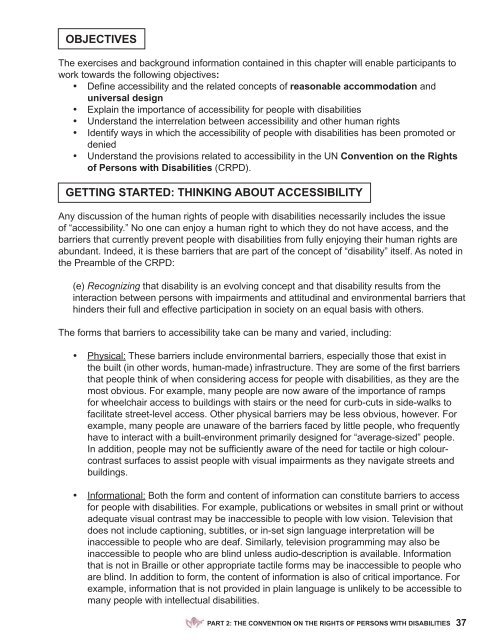Full page photo print - Harvard Law School Project on Disability
Full page photo print - Harvard Law School Project on Disability
Full page photo print - Harvard Law School Project on Disability
Create successful ePaper yourself
Turn your PDF publications into a flip-book with our unique Google optimized e-Paper software.
obJecTives<br />
The exercises and background informati<strong>on</strong> c<strong>on</strong>tained in this chapter will enable participants to<br />
work towards the following objectives:<br />
• Define accessibility and the related c<strong>on</strong>cepts of reas<strong>on</strong>able accommodati<strong>on</strong> and<br />
universal design<br />
• Explain the importance of accessibility for people with disabilities<br />
• Understand the interrelati<strong>on</strong> between accessibility and other human rights<br />
• Identify ways in which the accessibility of people with disabilities has been promoted or<br />
denied<br />
• Understand the provisi<strong>on</strong>s related to accessibility in the UN c<strong>on</strong>venti<strong>on</strong> <strong>on</strong> the Rights<br />
of Pers<strong>on</strong>s with disabilities (CRPD) .<br />
geTTing sTARTed: ThinKing AbouT AccessibiliTy<br />
Any discussi<strong>on</strong> of the human rights of people with disabilities necessarily includes the issue<br />
of “accessibility .” No <strong>on</strong>e can enjoy a human right to which they do not have access, and the<br />
barriers that currently prevent people with disabilities from fully enjoying their human rights are<br />
abundant . Indeed, it is these barriers that are part of the c<strong>on</strong>cept of “disability” itself . As noted in<br />
the Preamble of the CRPD:<br />
(e) Recognizing that disability is an evolving c<strong>on</strong>cept and that disability results from the<br />
interacti<strong>on</strong> between pers<strong>on</strong>s with impairments and attitudinal and envir<strong>on</strong>mental barriers that<br />
hinders their full and effective participati<strong>on</strong> in society <strong>on</strong> an equal basis with others .<br />
The forms that barriers to accessibility take can be many and varied, including:<br />
• Physical: These barriers include envir<strong>on</strong>mental barriers, especially those that exist in<br />
the built (in other words, human-made) infrastructure. They are some of the first barriers<br />
that people think of when c<strong>on</strong>sidering access for people with disabilities, as they are the<br />
most obvious . For example, many people are now aware of the importance of ramps<br />
for wheelchair access to buildings with stairs or the need for curb-cuts in side-walks to<br />
facilitate street-level access . Other physical barriers may be less obvious, however . For<br />
example, many people are unaware of the barriers faced by little people, who frequently<br />
have to interact with a built-envir<strong>on</strong>ment primarily designed for “average-sized” people .<br />
In additi<strong>on</strong>, people may not be sufficiently aware of the need for tactile or high colourc<strong>on</strong>trast<br />
surfaces to assist people with visual impairments as they navigate streets and<br />
buildings .<br />
• Informati<strong>on</strong>al: Both the form and c<strong>on</strong>tent of informati<strong>on</strong> can c<strong>on</strong>stitute barriers to access<br />
for people with disabilities . For example, publicati<strong>on</strong>s or websites in small <str<strong>on</strong>g>print</str<strong>on</strong>g> or without<br />
adequate visual c<strong>on</strong>trast may be inaccessible to people with low visi<strong>on</strong> . Televisi<strong>on</strong> that<br />
does not include capti<strong>on</strong>ing, subtitles, or in-set sign language interpretati<strong>on</strong> will be<br />
inaccessible to people who are deaf . Similarly, televisi<strong>on</strong> programming may also be<br />
inaccessible to people who are blind unless audio-descripti<strong>on</strong> is available . Informati<strong>on</strong><br />
that is not in Braille or other appropriate tactile forms may be inaccessible to people who<br />
are blind . In additi<strong>on</strong> to form, the c<strong>on</strong>tent of informati<strong>on</strong> is also of critical importance . For<br />
example, informati<strong>on</strong> that is not provided in plain language is unlikely to be accessible to<br />
many people with intellectual disabilities .<br />
PART 2: The c<strong>on</strong>venTi<strong>on</strong> <strong>on</strong> The RighTs of PeRs<strong>on</strong>s wiTh disAbiliTies<br />
37




